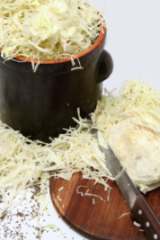Kimchi Recipes — Fermented Vegetables Offers Many Probiotic Health Benefits
Love kimchi? Hate kimchi? Don't know what kimchi is? While there are many different kimchi recipes, they all offer probiotic health benefits.
Kimchi is a fermented, Korean side dish. Traditionally, it is made with tiny shell fish, shrimp or fish sauce, but it works as well without the fish sauces as you will see below. Kimchi is a very spicy, red-hot food. However, since you are making it, you can certainly control the heat.
If you
are looking for a “how-to” for fermented vegetables, kimchi recipes are
excellent. The base vegetable of kimchi is usually cabbage. You can add
other vegetables and even fruit if you like. The cabbage used in making
kimchi is usually Chinese, but use whatever cabbage variety you like or
mix up the cabbages.
The beauty of making kimchi or other fermented vegetables is that you
can mix and match and substitute, but still come out with a very tasty product.
Most Kimchi keeps for weeks or months in your refrigerator.
Possibly the most important part of making kimchi or any other type of fermented vegetables is keeping the vegetables in a cool and airtight environment so proper fermentation will take place. To ensure the tastiest and most beneficial finished product for all of you kimchi recipes, use the freshest and ideally organic produce and the best salt available to you.
Simple Kimchi Recipe
Ingredients:
1 head of Chinese cabbage
1 cup of
real salt
3 green onions, chopped
1 clove of garlic, pressed or minced
2 tablespoons of
raw honey
½ inch of fresh ginger (or more), depending on how spicy you like your kimchi
1 tablespoon of cayenne pepper
Directions:
Cut the cabbage lengthwise, remove and discard the core. Rinse and clean the cabbage before chopping into into bite-sized pieces. Sprinkle the salt on the cabbage and place the salted cabbage in a plastic resealable bag, removing as much air as possible. Leave the cabbage in the tightly closed bag at room temperature for 6 hours.
After 6 hours, rinse the salt from the cabbage leaves and drain. Combine the rest of the ingredients and evenly distribute them over the cabbage. Use your hands to do this, but wear plastic gloves and make sure all the leaves are evenly coated. Place the cabbage mixture in an air tight container in a cool, dry place and leave it undisturbed for about 4 days. After 4 days, open the container, carefully and slowly let the fermentation gases escape. Then, store in the refrigerator for about a month.
Traditional Kimchi Recipe
Here is a more traditional kimchi recipe. This particular recipe uses a crock or glass bowl. You will also need a plate or lid that fits inside the mouth of the opening of the bowl. You'll want to produce an air-tight environment for the kimchi to ferment under the brine, so place a heavy weight on top of the lid using a clean rock or even a jar filled with water for weight.
Ingredients to make about 1 gallon of kimchi:
3 heads of cabbage, any variety or mix and match different kinds
1 turnip
2 bell peppers, any color
4 stalks of
celery
2 carrots
2
beet roots
8 cloves of fresh garlic
4 inches of fresh ginger
2 radishes, any kind or daikon radish
1 teaspoon of cayenne pepper
1 cup of real salt
1 TBSP of red miso
Directions:
Finely chop or slice all of the vegetables. Use a food processor and a mandoline to make this easier if you like. Mince or press the garlic and mince the ginger. Place all of the vegetables in a large bowl, adding the salt and cayenne pepper and mixing together using your hands. Mix thoroughly, massaging your kimchi. The combination of the mixed vegetables and the salt will soon have the vegetables releasing liquid; this liquid is the brine.
Taste your vegetables. The amount of saltiness will decrease, but the degree of spiciness will stay the same. Add anything else you may think your kimchi needs at this point. Some kimchi recipes add a small amount of fruit such as an apple, pear or even a small amount of raw honey. You can also add dried seaweed, sesame seeds or other seeds.
Stuff
the kimchi into a jar* or crock, packing it tightly and pressing it down
as you fill the container; you'll want the liquid to cover the
vegetables. Then, place a plate on top of the kimchi. This plate should
fit tightly inside the mouth of the crock or jar and should be in contact
with the vegetables; the air-tight cover will encourage safe
fermentation and prevent mold. Place the weight on top of the plate and
if the brine seeps over the plate that's fine, just make sure the
vegetables are covered with the brine.
Check your fermenting kimchi every day. Always make sure that the vegetables are covered with brine. If your kimchi lacks sufficient brine, add a bit of water. Remove the plate and press down on the kimchi daily. If you find any mold, remove it by skimming it off. You may have to wash the plate. Taste the kimchi daily during the process of fermentation. You can let the kimchi ferment for as little as 4 days or as long as 4 weeks, it's totally up to you and your personal tastes.
When your kimchi is at it proper fermentation, the way you like it, store the kimchi in the refrigerator since refrigeration will slow the fermentation process. Once refrigerated, the kimchi it will keep for several months.
Feel free experiment with these raw kimchi recipes. Enjoy your kimchi and all of its raw probiotic benefits!
* If using mason jars which I have done, I press down all the veggies and place a leaf of the cabbage on top of the veggies and place a washed rock to hold the veggies under the brine liquid. Can then remove the rock and leaf and the veggies have been kept in the brine liquid.
Favorite Cultured Recipe!
by Yvette Brooks
(Dallas, Texas)
1 head of cabbage
9 carrots
1 bunch of celery
About 3 inches of ginger root
1 to 2 cups of Hijiki seaweed
1 Tablespoon dill seed
cayenne pepper (optional and to taste)
4-5 (1 gallon) glass jars OR several mason jars
1. Wash vegetables, peel first few layers of cabbage reserve, cut heads into quarters.
2. Juice OR blend with a bit of added water the celery
3. Place 1-2 cups of Hijiki into celery juice and let soak for a least 30 minutes. The Hijiki mix will serve as your culture.
4.
Place portions of cabbage in food processor. Pulse to to cut (size is
preference, I like small to medium). Place the cabbage in a LARGE bowl.
5.
Cut 3X3 portion of ginger root. Cut the carrots into quarters OR shred
them. This is up to your preference, I like both ways.
6. Place the carrots and ginger in food processor and pulse until all is well combined.
7.Add carrot and ginger mix to prepped cabbage in your LARGE bowl.
8. Squeeze the excess juice from the soaking Higiki and add to the prepped vegetable mix.
9. Add the dill seed, and cayenne pepper if using. Toss all of the vegetables and seasonings evenly.
10.
Spoon the vegetable mixture into the glass jar filling it almost to the
top. Press the vegetables down to compact it as well as possible. Add
more of the vegetable mixture unto you have the jar filled but with
about a one inch head space. Pour 1/2 cup of culture into jar over the
vegetables. Refrigerate the rest of the culture in a glass jar in the
refrigeragoe for the next rime you make this
11. Fold one or more
of the reserved cabbage leaves on top of the vegetables to make a snug
fit. Put a lid on the jar. Repeat steps 10 and 11 until all of your
vegetable mixture is in jars.
12. Set jars aside for a few days,
about 3-5 to ferment. The warmer the temperature, the quicker your
fermented vegetables will be ready. You should see some bubbles forming
which is fine and a sign of an excellent batch.
13. When your
vegetables are fermented, store them in the refrigerator. You can add
these fermented vegetables to salads as a topping or to meals as a side.
Personally, I eat and serve my family 3 Tablespoons at a time with most
meals.
YUMMY AND NUTRITIOUS
Apple Kimchi
The following recipe was kindly submitted by health expert Sye Rodriguez. This recipe has been adapted from Sye's book, Sexy Fit!
Ingredients:
4 cups pure water
2 tablespoons sea salt
1 apple
1/2-3/4 of a head of cabbage
1-2 cucumbers
1-2 inch piece of fresh ginger 6-7 fresh peppers (no need for them to be hot unless you prefer that)
7 cloves garlic
1 medium onion
1 head of broccoli
Directions:
Combine the water and the salt and set aside. Cut all of the vegetables into small but not tiny pieces. Place them in a bowl and mix together.
Place the cut vegetables into jars. Quart canning jars works well for this. Press the vegetables down to get out as much air as possible. Fill the jars to about 1/4 inch from the top with the salt water solution. Cover the vegetables with a folded cabbage leaf and place a stone on top of the cabbage leaf to hold them under water. Place an airtight seal on the jars.
Store your jars in a dark place for four days. Every day loosen the lid on the jars to release the pressure, then re-tighten. After 4 days, store the jars in your refrigerator. Enjoy your kimchi, it will keep in your refrigerator for about six months.
Most people like to discard the top cabbage leaf. You can eat it but it may be discolored.
Hungry for more?
Here are some other pages on fermentation:
Go from Kimchi Recipes to HOME of Raw Food Diet Magazine
Follow
Guide with Over 50 Recipes!

Guide to Super Raw Foods is now available for Kindle or paperback on Amazon

Sign-up for Newsletter and get my Free E-Book Go Raw Not Crazy
Check Out These Sites:





